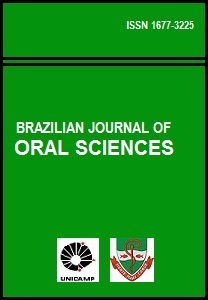Abstract
Aim: To investigate the electromyographic activity of masticatory muscles in women with myogenic or mixed TMD treated with ultrasound and ultrasound associated with stretching. Methods: Sixteen women with myogenic or mixed TMD, according to the Research Diagnostic Criteria for Temporomandibular Disorder (RDC/TMD), participated in the study. The patients were evaluated using surface electromyography (sEMG) of the masseter and anterior temporalis muscles, during maximum intercuspation, before and immediately after application of therapeutic resources. All patients were treated by ultrasound (US), ultrasound associated with stretching and placebo ultrasound, by turns, once a week with a one-week minimum interval between them. Results: There was greater symmetry of the masseter muscle electrical activity after ultrasound associated with stretching (p=0.03). The electromyographic values for the maximum intercuspation as well as the symmetry of anterior temporal muscle (p=0.47, p=0.84, p=0.84) and anteroposterior coefficient (p=0.07, p=0.84, p=0.57) showed no statistically significant difference after the intervention, placebo, ultrasound and ultrasound with stretching. Conclusions: These results indicate that a single application of ultrasound and ultrasound associated with stretching were not able to modify the activity pattern of the masticatory muscles during maximum intercuspation, except the symmetry of the masseter muscle that increased with the last, in women with myogenic or mixed temporomandibular disorder.
This work is licensed under a Creative Commons Attribution 4.0 International License.
Copyright (c) 2015 Jalusa Boufleur, Eliane Castilhos Rodrigues Corrêa, Lais Chiodelli, Ana Maria Toniolo da Silva, Lilian Gerdi Kittel Ries
Downloads
Download data is not yet available.

